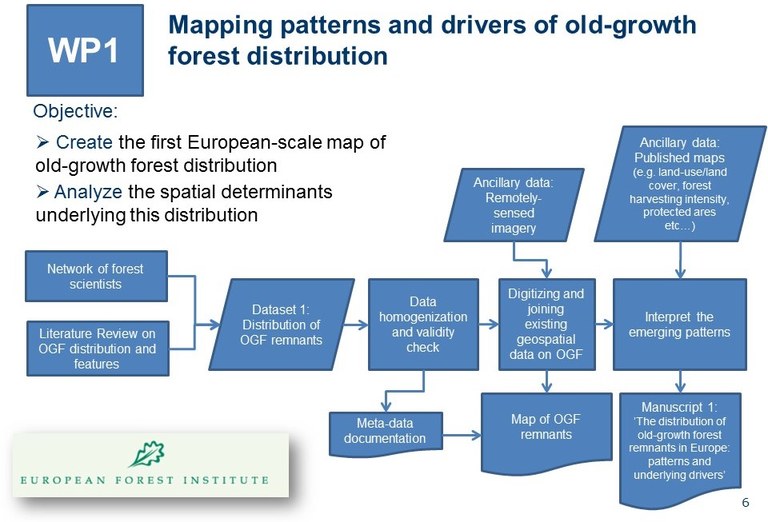FORESTS and CO - Work package Description
Work package 1: Mapping patterns and drivers of old-growth forest distribution
Work package 2: Assessing co-benefits and conflicts between carbon storage and biodiversity conservation
Work package 3: Patterns of co-occurence between plant diversity and carbon stocks in European forests
Work package 1: Mapping patterns and drivers of old-growth forest distribution
Objective: Build a network of forest researchers and perform a literature review to gather existing data on old-growth forest remnants in Europe. Create the first European-scale map of old-growth forest distribution and analyze the spatial determinants underlying this distribution.
Description of the activities: We will gather data on the spatial distribution of European old-growth forests via (a) a literature review (including gray literature) and (b) the establishment of a network of forest scientists from all European Countries. We will establish a geodatabase of old-growth forests in Europe, including accompanying metadata, and digitize old-growth forest boundaries where necessary. Based on this geodatabase, a map of old-growth forest remnants in Europe will be created at a nominal scale of ca. 1:2,000,000 (minimum mapping unit 10 ha). We will first compare the old-growth forest dataset to a map of protected areas to assess the distribution of old-growth forests remnants inside and outside of protected areas per country, and among protected areas of varying protection status (different IUCN categories, Natura2000 sites). Second, we will carry out a literature survey to identify potential climatic (e.g., growing-degree days, rainfall), topographic (e.g., elevation, slope), socio-economic (e.g., accessibility, population density), and historic (e.g., past land use) variables explaining old-growth forest patterns. We will analyze the drivers of old-growth forest distribution using multiple regression analyses (i.e. comparing BMA and BRTs). The dependent and all independent variables will be gathered/summarized at the 1-km grid level.
Deliverables: D1.1 – Geodatabase and map of old-growth forest distribution; D1.2 – Manuscript: ‘The distribution of old-growth forest remnants in Europe: spatial patterns and underlying drivers’.

Objective of the WP: Model the relationship between different biodiversity indicators and forest carbon stocks in European forests, using old-growth forest remnants as a benchmark.
Description of the activities: A database of forest carbon, forest structural and biodiversity data of European managed and unmanaged forests will be designed and assembled using data collected during the literature review (WP1), and original data provided by forest scientists which will join the collaborative network, building upon the network of researchers established in WP1. Biodiversity data will refer to several taxonomic groups (e.g. plants, mosses, lichens, saproxylic beetles and fungi, birds and small mammals). For each stand, we will calculate the classical (e.g. species richness, Shannon’s entropy), and\or derived diversity indices (e.g. functional, phylogenetic) of each taxonomical group. Forest structural data will include growing stock and aboveground biomass. Growing stock will be converted to biomass data using expansion factors. We will then explore and reduce the heterogeneity of the dataset by, for example, discarding data which do not meet an adequate quality standard, data transformations, resampling or downsampling to a common standard (e.g. in case of data using different tree diameter threshold). We will then test the hypothesis that forests storing greater amounts of aboveground biomass (as a proxy of C stock) host higher biodiversity, both through parametric (e.g. Bayesian Modeling Average) and non-parametric multiple regression techniques (e.g. Booster Regression Trees), using each forest stand in the dataset as a replicate. Other forest structural data (e.g. tree density, basal area, coarse woody debris), as well as stand environmental parameters (elevation, topography, climate), and management practices will be used as covariates. We will finally build carbon\biodiversity trade-off curves. Depending on the sample size, the results will then be compared between old-growth and differently managed stands (even- vs. uneven-aged), as well as between forest types (e.g. coniferous and deciduous stands). We will then draw inferences on whether forest management prescriptions aimed at increasing carbon storage may yield co-benefits for biodiversity conservation.
Deliverables: Deliverable 2.1 – Manuscript: ‘Co-benefits and conflicts between carbon storage and biodiversity conservation in European forests’

Objectives of the WP: Test how plant diversity indicators, calculated on the basis of data contained in the European Vegetation Archive, relate to forest carbon stocks at the regional scale.
Description of the activities: We will derive and map mean forest diversity indices (alpha-, beta-, and gamma-diversity) for European bioclimatic regions and\or ecoregions (EEA’s DMEER) using forest-plot vegetation data contained in EVA. This data will be resampled to minimize bias due to the uneven geographical distribution of plots. Each geographical unit will be characterized in terms of average and standard deviation living forest biomass and carbon stocks, and other covariates (land-cover, climate, topography and management regimes). We will model the relationship between plant diversity and regional-scale carbon stocks, using the same regression techniques as in WP1. Finally we will build regional-scale carbon\biodiversity trade-off curves.
Deliverables: Deliverable 3.1 – Manuscript: ‘Patterns of co-occurrence between plant diversity and carbon stocks in European forests’

